Many software projects never see completion despite being based on excellent ideas with a competent team. Even more projects exceed their original budget estimates or need to be completed on time. Choosing the wrong software development models is a common reason why this happens.
In this article, we will:
- Highlight the benefits of choosing the suitable software development model .
- Review the most popular SDLC models: Waterfall, Agile and its derivatives (Kanban, Scrum, Lean), Spiral, DevOps, XP, RUP, Incremental and Iterative, and V-model. The review of each includes pros, cons, use cases, and software development models life cycle.
- Help you select the best model for your project based on project requirements.
Benefits of using a software development model
The right choice of models in software development makes all the difference for your project. With the suitable software development model, the project is well-organized, the team is productive, and all aspects are accounted for, leaving the customer satisfied. Let's examine how the choice of SDLC models impacts the software development process and result.
- It will help you align with project requirements
Different projects have varying requirements and problems.
Choosing suitable software development models and methodologies helps tick all the boxes and fit the project into the format that will move it forward most efficiently. For example, a project with well-defined requirements from the start might benefit from the Waterfall model, whereas a project expected to undergo changes would be better suited for Agile methodologies .
- It will enhance team productivity
The right SDLC model can streamline development, clearly define roles and responsibilities, and set realistic timelines. For instance, Agile frameworks like Scrum can enhance team productivity by breaking the project into manageable sprints.
- It will account for risks
If risk aversion is the most important factor for your projects, models like Spiral and RUP will help to avert the risks. These software development models and methodologies will help you implement strategies to mitigate these risks before they can significantly impact the project at the beginning.
- It will improve product quality
A suitable model for development means continuous integration, adequate testing, and a review process. All of these factors help to improve the quality of a product . A very popular Agile framework is known for continuous product improvement.
- It will keep stakeholders satisfied
Agile-like models keep customers involved in all stages of product development . This continuous engagement ensures that the product evolves according to stakeholder expectations and needs, directly impacting customer satisfaction.
- It will optimize resources and keep the budget in check
Overspending on a project can result from selecting the wrong software models. For resource optimization, you have models like Lean that focus on waste management. Agile-like models and Waterfall are pretty inexpensive, but the truth is that no model is too expensive if it fits the product requirements.
- It will facilitate communication between teams
Development models emphasizing collaboration (e.g., Scrum, Kanban) promote open communication channels between different teams. DevOps goes one step further by bringing operational and development teams together.
- It will keep documentation clear
Software development life cycle (SDLC) models like V-Model strongly emphasize documentation at each development phase. This is particularly important for projects in regulated industries or where future maintenance and scalability are concerns.
Web application for investment
Our dedicated development team created a feature-rich investment marketplace designed for heavy data loads.
In-depth exploration of SDLC models
Software development models are the methodologies that determine the process of working on a software development project. The model determines how exactly:
- To perform tasks
- To evaluate the performance of the team
- To monitor the results
- To interact with customers and other stakeholders
- To break the development into stages/cycles
- To manage risks
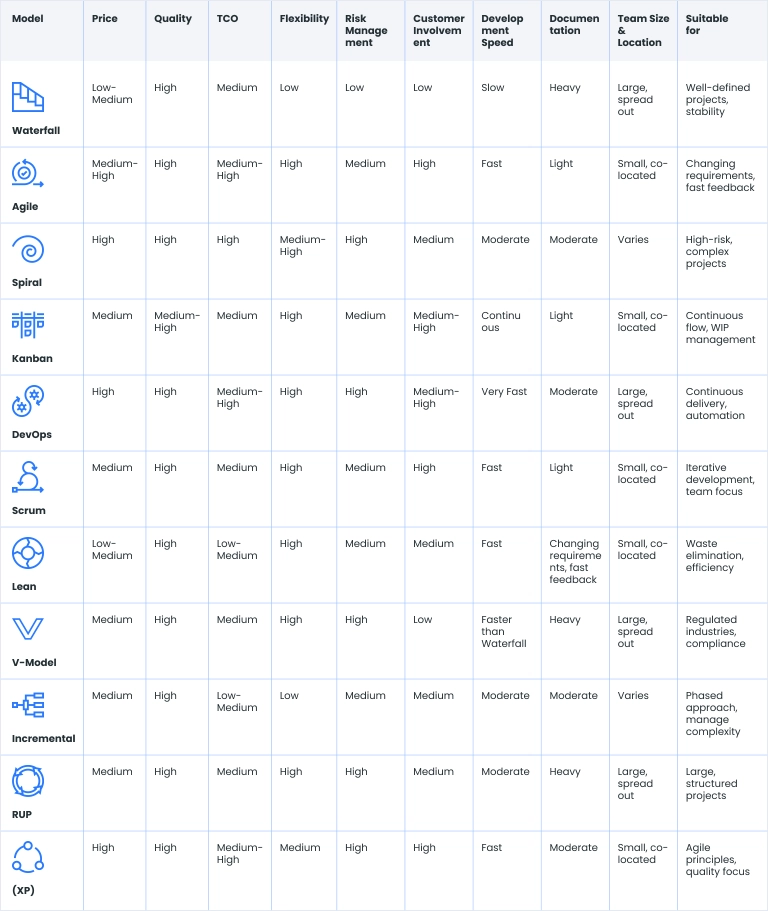
Let's look into the most popular SDLC models: their structure, benefits, drawbacks, and what types of projects work best with each model.
1. Waterfall
This sequential model is considered relatively easy to understand and manage due to its linear approach. Each phase has specific deliverables and a review process with detailed documentation of every stage, and each stage begins only after the previous one has been completed.
However, the drawback of Waterfall is that it is inflexible to changes and unsuitable for projects where requirements may evolve. It is also challenging to correct bugs in this model. The waterfall software development model is well-suited for short, simple projects with well-defined requirements that do not have to be altered during the development process.
In 2025, the Waterfall model is still widely used for projects where it fits all the requirements, though it is one of the oldest software models. Governments and large corporations often use Waterfall in their current, simple IT projects. However, Agile-like SDLC models now take preference in more innovative projects.

2. Agile
Agile is highly flexible and adaptable to changes. It is not just one, but a bundle of models for agile development that reflect the 2001 Agile Manifesto. Agile is a collection of principles that different models can use as the basis. Adaptability and flexibility are at the heart of all SDLC models built on Agile.
Agile promotes customer involvement and iterative feedback. The project is broken into cycles monitored closely by stakeholders. However, it can be chaotic if not well managed. As a rule, Agile requires strong customer involvement and commitment. So, if the project cannot guarantee it, using Agile is not the best idea.
Agile suits projects with uncertain or evolving requirements in dynamic and complex environments. Agile is also great for projects that need feedback right away. Agile projects have frequent releases and constant project improvement.
In 2025, Agile-like software development life cycle (SDLC) models are the most popular for web and mobile apps, games, and startups. Since Agile models in software development are so customer-centered, they are perfect for building products that customers actually love.

3. Spiral
Spiral software development model focuses on early identification and reduction of risks. Spiral is all about mitigating risk; it is its primary purpose.
The Spiral model of software development is "spiral-like" due to its iterative nature, where the development process is visualized as a spiral with many loops. Each loop of the spiral represents a phase in the process, and each phase is composed of four main quadrants: Planning, Risk Analysis, Engineering (design and implementation), and Evaluation (customer review).
It allows for iterative refinement through each spiral loop. One notable disadvantage of this software development model is that it is costly and more complex to manage. It is also time-consuming, and the risk assessment in the case of Spiral requires expertise. Since the number of loops is unlimited, there is a risk of exceeding the budget. The model is also customized, so the structure cannot be reused for the next project.
Despite all the complications, this is indeed the best model on the market for risk analysis. It is best used in large, complex, high-risk projects requiring early feedback. Spiral is the most popular model for high-risk environments like medical, telecommunications, and military systems.
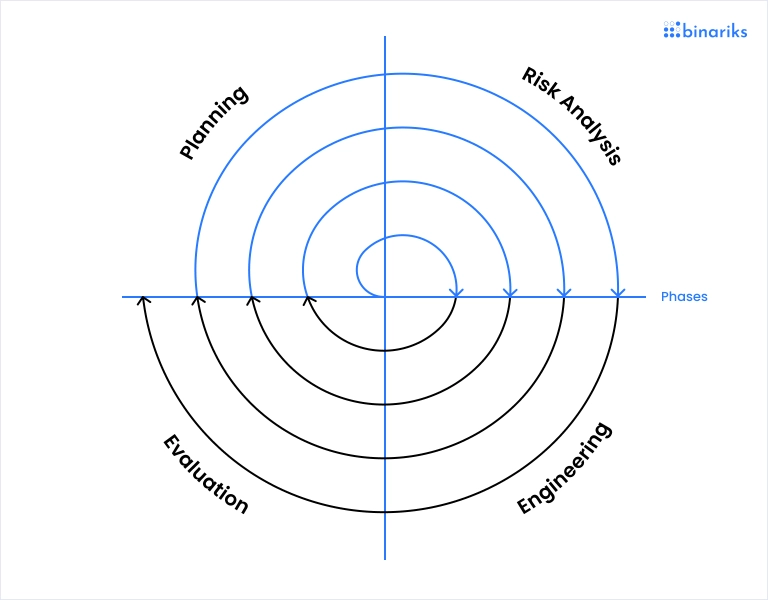
4. Kanban
Kanban is a derivative of Agile, focusing on visualization and work-in-progress limits. The Kanban software development model increases efficiency through visual management. It allows for continuous delivery with minimal disruption.
Compared to other software development models, it is less structured, which can lead to prioritization issues. Overall, Kanban requires discipline to maintain flow.
It is best used in maintenance projects, ongoing improvements, and projects where teams have a steady workflow. In one famous case, Pixar uses Kanban to visualize the animation flow (Source ).
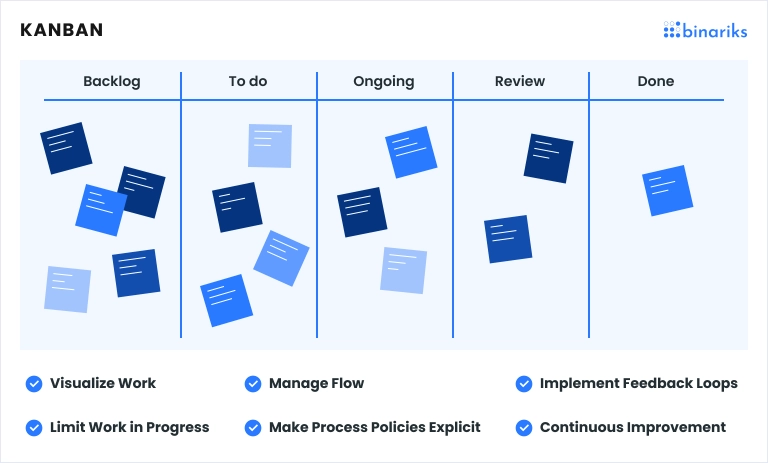
5. DevOps
DevOps is the unique model in software engineering that brings together software development and operations teams. One obvious benefit of DevOps is that it enhances collaboration. It also shortens the system development life cycle and provides continuous delivery with high software quality.
However, DevOps also requires a cultural shift and buy-in from all stakeholders, and it can be challenging to implement, as many customers are not used to unorthodox DevOps methods.
DevOps is best for organizations aiming for rapid development cycles and continuous deployment. One of the famous adepts of DevOps is Netflix, which supports its entire platform with this development model (Source ).
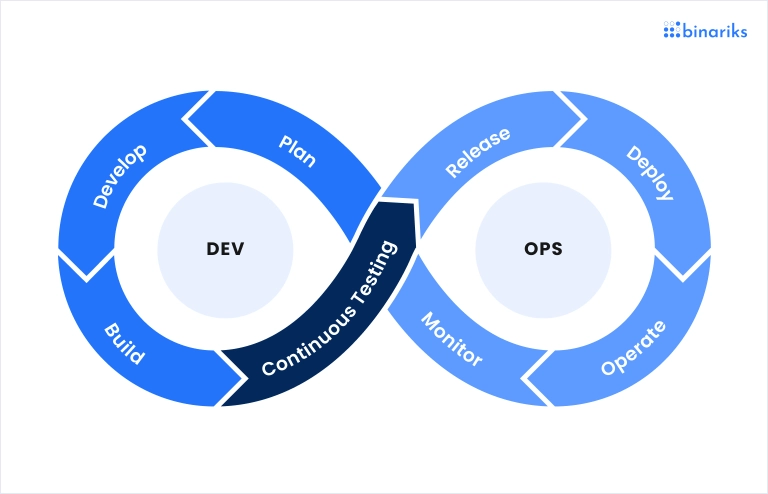
6. Scrum
Scrum is a software development model based on Agile for developing projects in sprints. It provides flexibility in handling changing requirements. It also empowers teams to make decisions and adapt quickly. While flexible, Scrum can also lead to scope creep without strict controls. It requires committed and experienced team members.
Because of that, Scrum is best for complex projects that require quick responses to change. If it makes sense for your project to be done in sprints, Scrum is your software development model; it is as simple as that.
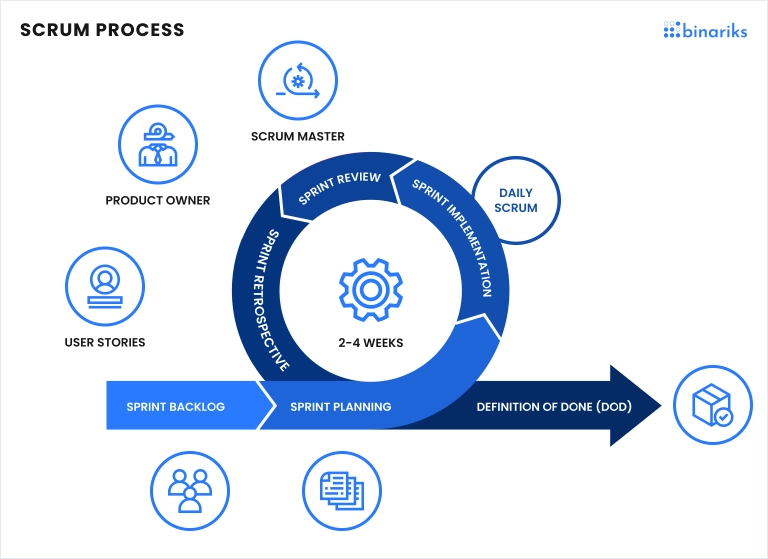
7. Lean
Lean is a model that eliminates waste, improves quality, and delivers faster by optimizing the flow. This is yet another Agile model, but the focus is on eliminating everything that a project does not need. However, it requires a deep understanding of Lean principles and commitment throughout the organization.
Lean is best for any software development process looking to improve efficiency and eliminate non-value-adding activities. Fun fact: Lean originated from Toyota manufacturing in the 1940s (Source ).

8. V-model
The V-Model is called the "V-Model" because of its visual representation, which resembles the letter "V." This model is an extension of the Waterfall model and emphasizes the verification and validation phases of the development process.
The left side of the "V" represents the decomposition of requirements and the sequential stages of software development (such as requirements analysis, system design, and architecture design), leading down to the coding phase at the bottom of the "V."
The right side of the "V" represents the integration of components and the sequential stages of testing (unit testing, integration testing, system testing, and acceptance testing), leading back up to the completion of the project.
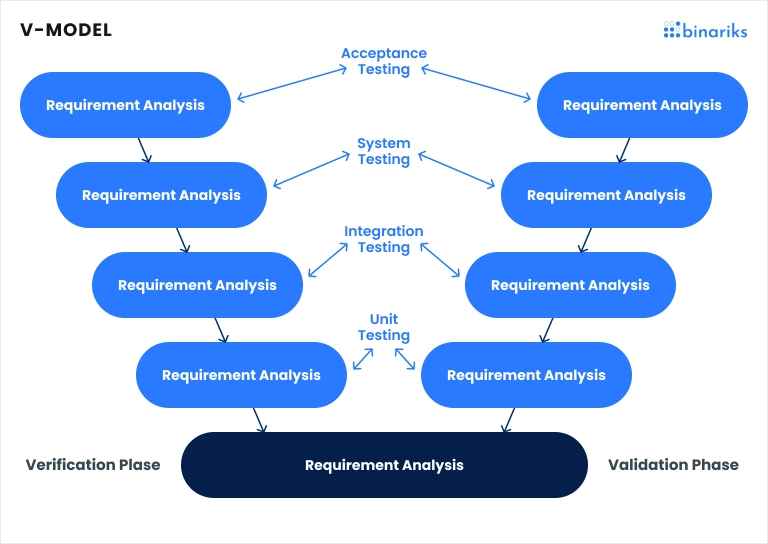
V-model emphasizes planning and design phases. This is the model to choose for thorough testing before implementation. V-model supports testing at every stage instead of at the end of the entire development cycle. One notable disadvantage is that, like Waterfall, it's inflexible to changes and assumes requirements are well understood early on.
V-model is ideal for projects with well-defined requirements and where changes are unlikely. Even though you can define bugs with the V-model, fixing them would be difficult. The v-model is mainly used in embedded, safety-critical, government, and financial systems.
9. Incremental and Iterative
Incremental and Iterative models of software development allow for partial delivery of the product. The life cycles of these software development models are repetitive over short periods. With each new cycle, the actions are repeated with additional requirements.
Incremental and Iterative facilitates the early detection of issues. One thing to consider, however, is that initial iterations may fail to deliver significant functionality. Therefore, it requires good planning and design.
Incremental and Iterative are best for projects where early partial delivery is beneficial, and the product can be moved forward with each step. It is also suitable for evolving requirements. With this model, developers can figure out what works and what does not work on the go. However, the basic framework of the project still has to be followed, and the changes cannot be radical. Incremental and Iterative is quite expensive compared to other models.

10. The Rational Unified Process (RUP)
RUP provides a flexible and adaptable framework that can be tailored. It is all about accurate documentation. What is more, RUP is one of the most popular SDLC models for risk management. The basis of RUP is Unified Modeling Language (UML). With RUP, the project is broken into iterations lasting between 2 and 4 weeks.
One pain point with RUP is that it can be complex and cumbersome for small teams or projects that do not work best with short sprint iterations expected to provide results within weeks. It also requires expertise for effective implementation.
RUP is best suited for complex software projects that need rigorous development processes and where risks must be carefully managed. These projects tend to be large, and their requirements change constantly. Otherwise, RUP can be too expensive and time-consuming for other projects.
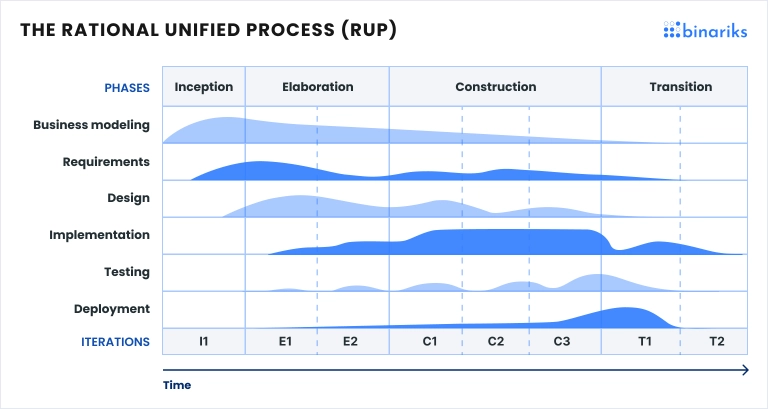
11. Extreme Programming (XP)
XP enhances software quality and responsiveness to changing customer requirements. Features include emphasizing teamwork, customer involvement, and frequent releases.
The core principles of XP are close to those of Agile. However, XP requires close and continuous communication with the customer. It may not be suitable for teams that are not co-located . Like in Scrum, teams using the XP software development model work in iterations, but XP iterations are more flexible in length, and the focus is on continuous testing instead.
A perfect implementation for XP is for projects with rapidly changing requirements, small to medium-sized teams, and where the risk of changing requirements is high.

Software development life cycle models comparison

Transform your business with our quality-centric software solutions. Embrace Lean and Agile methodologies with Binariks!
Selecting the right SDLC model & influencing factors
We have looked into the factors that address the choice of models in software engineering when discussing each model. Let's re-evaluate the factors once again:
- Project complexity: Simple projects benefit from Waterfall and the V-model, while more complex ones work best with Agile-like and spiral models.
- Requirements clarity: Well-defined projects work well with stable models like Waterfall while evolving projects are best with Agile and XP.
- Risk management: If the project has many risks, RUP and Spiral are software development models to choose from.
- Customer involvement: Agile-like methodologies are the best for projects where customer feedback is essential, while Waterfall and similar models limit customer involvement.
- Time to market: Agile-like methodologies are the right choice for projects that are developed fast.
- Team size and experience: Agile and XP are well-suited to small, cohesive teams with high autonomy and expertise. For larger teams or teams with varied experience levels, models with more structure and documentation, like RUP or Waterfall, are better.
- Budget: Waterfall and V-Model are best for projects with strict budgets, while Agile has more budget flexibility.
- Regulatory compliance: Waterfall and V-Model work best for industries with strict requirements.
Below is the table with an overview of models to choose and not to choose for various projects:
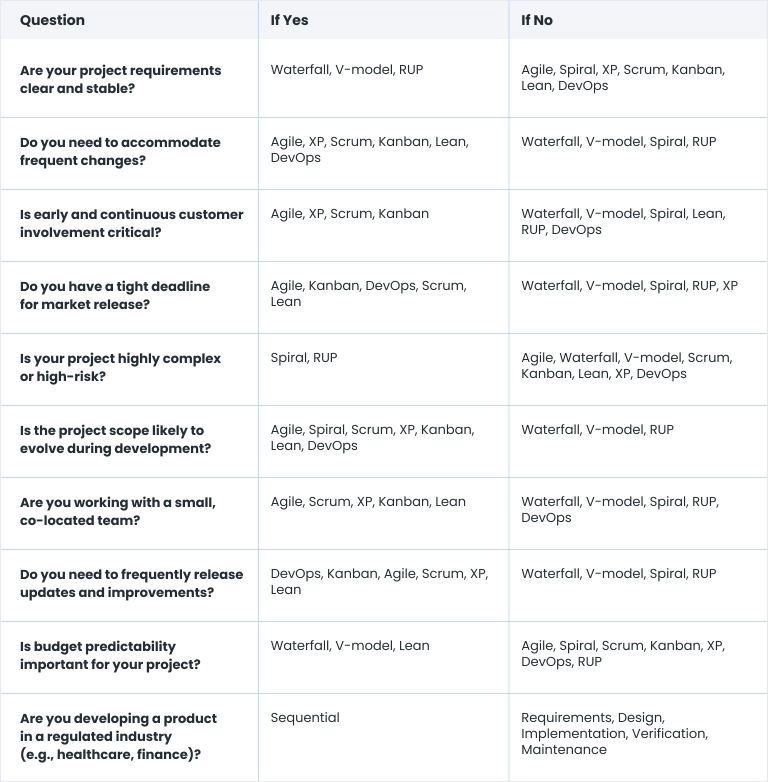
Conclusion
To conclude, there are software development models capable of maximizing every software project's potential. To succeed, you need to consider every single important factor for your project and choose the SDLC model that fits the scope of your project the best.
At Binariks, we can help you evaluate the project requirements, risks, team dynamics, stakeholder involvement, and workflow to select the software development model that makes the most sense for your project. We execute this for the projects we work on as remote teams and for your other projects as a third-party consultant.
Share

